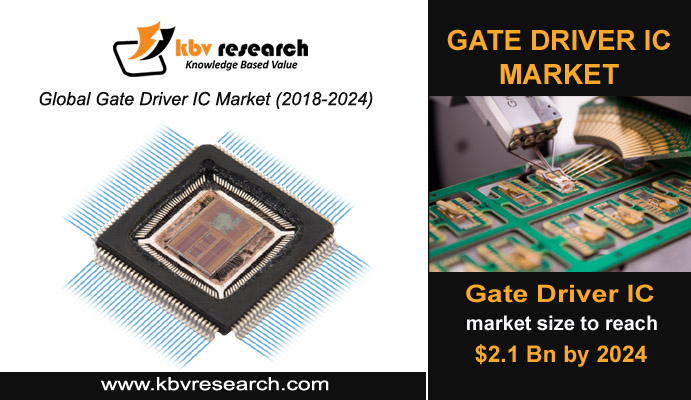
The growing prevalence of digital electronic devices, adoption of progressive electronic vehicles and advanced virtual systems have paved the way for huge growth opportunities for the Gate Driver IC technology. New products are being implemented by emerging industry players and smaller semiconductor companies are being acquired to strengthen their market presence and deliver power modules of the next generation.
Gate Drivers accept low-power input from an IC (Integrated Circuit) controller and generate high-current drive input for a high-power transistor gate such as IGBT or Power MOSFET. Integrated Circuit is a semiconductor wafer which is fabricated with thousands of tiny resistors, capacitors, and transistors.
An IC has a wide variety of features, including amplifiers, oscillators, timers, computer memory, and microprocessors. A gate driver IC acts as an interface between power switches and control signals. Power switches include IGBTs, MOSFETs, SiC MOSFETs, and GaN HEMTs. These solutions help to reduce the complexities of design, time for development, materials bill and board space. In addition, technology is intended to improve reliability.
Gate driver ICs are suitable for a variety of applications including major home appliances, industrial motor drives, solar inverters, UPS, switched-mode power supplies, high-voltage lightning, etc. In addition, the use of power transistors in different renewable energy systems has accelerated the acceptance among major manufacturers of gate driver ICs. Increased use of gate drivers for silicon carbide and gallium nitrite gate drivers implies advanced protection against short-circuiting.
A system needs a switch in most applications to be able to work properly. Since there are no ideal switches, the component has been selected for this task almost all the time is a MOSFET. Typically, a MOSFET needs a gate driver at the preferred frequency to do the on/off operation. MOSFETs include a gate drive circuit for translating the on/off signals from an analog or digital controller into the power signals needed to control the MOSFET.
Increasing urban development, climate change, and demographic changes are encouraging cities to develop their infrastructure to ensure seamless integration of renewable energies and stable grids while maintaining quality of life for urban residents as well. In addition, electronic systems are made compatible with technology upgrades due to improved technology optimization. Home appliances and other electronic systems are designed to interact with consumers via the internet, especially in-house security infrastructures such as automated door locks, smart plugs, and lightning. Therefore, adopting smart home and smart grid technology drives gate driver ICs sales.
MOSFET driver ICs are implemented in power supply and motor driver applications to drive external MOSFETs. Typically architected in a bridge configuration, MOSFET drivers deliver the timing needed to ensure that only one MOSFET is operated at a time. For multiple applications, MOSFET drivers are used, including motor drivers and load switching to power supplies.
Click Here For Free Insights: https://www.kbvresearch.com/news/gate-driver-ic-market/
For increased efficiency in isolated designs, single and dual drivers with secondary-side synchronous drivers exist across the market space. Assessment kits are available for rapid prototyping and design verification. A system needs a switch in most applications to be able to function properly. Since there are no ideal switches, mostly a MOSFET is the component selected for this task. Generally, a MOSFET needs a gate driver to perform the on/off operation at the desired frequency. A MOSFET is an acronym for the metal-oxide semiconductor's field-effect transistor. It is a field-effect transistor (FET), the main component in high-frequency, high-efficiency switching applications throughout the electronics industry. A MOSFET is a device controlled with four terminals namely a gate, a drain, a source, and a bulk.
An insulated gate bipolar transistor (IGBT) is a three-terminal power semiconductor device that is widely used as an electronic switch that combines high efficiency with rapid switching as it has been developed. It consists of four alternating layers (P-N-P-N) controlled by a metal-oxide-semiconductor (MOS) gate structure without regenerative action. The IGBT combines the simple gate-drive features of MOSFET with bipolar transistor high-current and low-saturation-voltage capabilities.
The IGBT incorporates as a switch in a single device an isolated FET gate for the control input and a bipolar power transistor. The IGBT is used in medium to high-power applications such as power supplies switched-mode, traction motor control, and induction heating. Large modules usually consist of many parallel devices and can have very high current handling functionality in the order of hundreds of amperes with 6500 V blocking voltages. These IGBTs are capable of controlling loads of hundreds of kilowatts.
Design complexity is one of the main reasons that slow down Gate Driver ICs' proliferation. In microprocessors, there are many transistors that should be highly reliable and have long lines of copper. The IC port driver design chain is much more complex than other processors. Various complexities, such as slimmer IC versions, cabinet usage, and others, impede the efficiency of gate drivers. Vigilant attention, precision, and skilled workforce are needed to create an appropriate gate driver, acting as a key obstacle to this industry's development.
Growing global concerns about climate change's negative effects along with alarming levels of pollution recorded in major cities have generated significant demand for electric vehicles. Due to higher petrol and diesel prices, demand for fuel-efficient vehicles has recently increased. Gate driver ICs play an important role in providing optimal solutions across a wide range of electric vehicle applications such as on-board chargers, grid-supporting energy storage, and high-power chargers.
Moreover, it is expected that the electric vehicle industry will record a substantial growth equivalent to the increase in its charging infrastructure. Therefore, the rise in electric vehicle adoption globally is expected to have a positive impact on the sales of gate driver ICs, which facilitates the efficient and high-power density supply of the vehicle. The Global Gate Driver IC Market is also expected to grow at a CAGR of 8% over the forecast period.